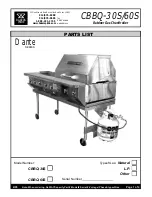
Location
The water heater should be located as close as possible
to the chimney and to the main use of hot water. This
location must not be subject to freezing tempera-
tures. The water heater should be positioned, so that
there is easy access to the burner, gas control valve,
and drain valve. It must be located close to a suit-
able free-flowing floor drain. Where a floor drain is
not adjacent to the water heater, a suitable drain pan
must be installed under the water heater (see Figure
8).
This drain pan should be at least four (4) inches
(10.2 cm) larger than the diameter of the water heat-
er, and at least one (1) inch (2.5 cm) deep providing
access to the drain valve. This pan must not restrict
the flow of ventilation and combustion air. This pan
must be piped to a suitable drain to prevent damage
to property in the event of a water leak from the piping,
the relief valve, or the water heater.
Sooner or later, all water heaters leak. The
manufacturer, based on national building codes,
has given the necessary instructions to prevent
damage to the building. Under no circumstances
is the manufacturer to be held liable for any water
damage in connection with this water heater.
This water heater is approved for installation on either
a combustible or non-combustible floor. However,
should this water heater be installed directly on car-
peting, the carpeting must be protected by a wood or
metal panel beneath the water heater. This panel must
extend at least three (3) inches (7.6 cm) beyond the
width and depth of the water heater. Should the water
heater be installed in an alcove or closet, the entire
floor area must be covered by the panel.
Minimum Clearances
The minimum clearances from combustible material
for this water heater are: Two (2) inches (5.1 cm)
from the sides and rear, four (4) inches (10.2 cm)
from the front, and eighteen (18) inches (45.7 cm)
from the top (see Figure 1).
Combustion and Ventilation Air Supply
In order for the water heater to operate properly, it must
be supplied with an uninterrupted flow of clean com-
bustion and ventilation air. The area around the water
heater must always be kept clear and the combustion
air intake holes at the bottom of the water heater
must never be blocked. An inadequate supply of air
to the water heater will produce a bright yellow burner
flame causing sooting in the combustion chamber,
on the burner, and in the flue tube. This can result in
damage to the water heater and serious bodily injury, if
not corrected.
Combustion and ventilation air requirements are
determined by where the water heater is to be locat-
ed. Water heaters are installed in either open (uncon-
fined) spaces or smaller (confined) spaces, such as
closets or small rooms.
4
INSTALLATION INSTRUCTIONS
18''
min.
2'' min.
2'' min.
2'' min.
4'' min.
IMPORTANT
These instructions have been written as a guide for the proper installation and operation of your water heater,
and the manufacturer of this water heater will not accept any liability where these instructions have not been fol-
lowed. However, for your safety and to avoid damage caused by improper installation, this water heater must be
installed by a Certified Licensed Professional, and meet all local codes or, in the absence of local codes, CAN/
CGA B149.1 Natural Gas Installation Code or CAN/CGA B149.2 Propane Gas Installation Code, in Canada, and/
or the National Fuel Gas Code, ANSI Z223.1, in the United States.
Before proceeding with the installation instructions:
1)
Inspect the water heater and its component parts for possible damage.
DO NOT
install or attempt to
repair any damaged component parts. If you detect any damage, contact the dealer where the water
heater was purchased or the manufacturer listed on the warranty card.
2)
Verify that the type of gas being supplied corresponds to that which is marked on the rating plate and
gas control valve of the water heater.
Figure 1





































